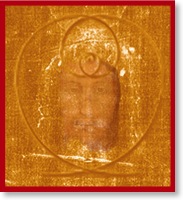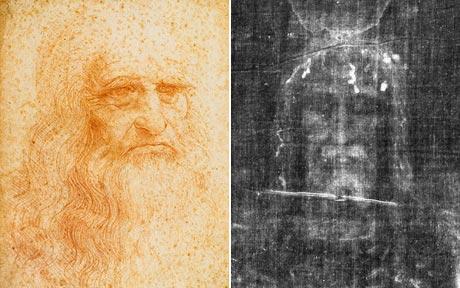
October 13, 2009
Shroud Image Controversy
Recent media driven discussions revolving two topics, have brought back into the limelight the old issue of whether Leonardo da Vinci was the creator of the Shroud of Turin.
One topic swirls around Vatican researcher Barbara Frale’s Templar revelations. These revelations appear to add weight to the authenticity issue. Secondarily is the Italian professor of organic chemistry, Luigi Garlaschelli claims that he has reproduced the Shroud image using materials and techniques available in the Middle Ages. If most of the world would simply look at the object as an archeological object instead of a relic, it would clear the muddy water considerably swirling around the discussions.
For Frale - Garlaschelli issues see http://www.jamesabarrett.com/page19/shroudnews.html
On October 13, 2009, Ian Punnett host of the radio show Coast to Coast welcomed authors Lynn Picknett and Clive Prince, who discussed the Shroud of Turin and these allegations. In their book Turin Shroud: In Whose Image?, published sometime in the mid-1990s, they claimed the relic, was actually a medieval creation. Picknett was critical of the Garlaschelli recent work, with the odd rationale that “…he didn't replicate the unique characteristics found in the cloth”. I found this most interesting; especially when you consider that Prince and Picknett believe Leonardo da Vinci faked the Shroud and that he used his own face as a model. Because the Shroud image has certain properties of a photograph, they suggest he used a camera obscura, an early photographic device, to project his image onto the cloth. Further they argue da Vinci's painting of Salvatore Mundi, which bears a close resemblance to the face on the Shroud. These two facts the authors find to be compelling evidence of his involvement.
Please!!!!
The evidence cannot support the very idea that Leonardo da Vinci created the Shroud image. The Shroud as an archeological artifact has several anomalous characteristics and a mountain of hard and circumstantial evidence that cannot be ignored when posing a theory for the image creation.
Making wild claims appears to be pure intentional journalistic sensationalism and more entertainment then real research. It is my opinion that this is tabloid journalism plain and simple.
FACTS:
Shroud Provenance with Dates!
- Leonardo di ser Piero da Vinci was born April 15, 1452 which is one hundred years after the known provenance of the Shrouds European emergence. He died May 2, 1519.
- He was born in the Tuscan hill town of Vinci, in the lower valley of the Arno River in the territory of Florence.
- The known provenance of the cloth stored in Turin dates to 1349-1357, when the widow of the French knight Geoffroi de Charny (said to be a descendant of Templar Geoffroy de Charney who was burned at the stake with Jacque de Molay the Templar Grand Master) had it displayed in a church at Lirey, France (diocese of Troyes region of the Burgundian Kingdom).
- On 20 June 1353, Geoffroy de Charny, Lord of Savoy and Lirey, founded at Lirey, in honor of the Annunciation, a collegiate church with six canonries, and in this church he exposed for veneration the Holy Winding Sheet.
- The Bishop of Troyes declared after inquiry that the relic was nothing a fake and opposed its exposition.
- Clement VI, by four Bulls (pronouncements), 1390, approved the exposition as lawful.
- Margaret de Charny the only grandchild of Geoffroi travelled with it prior to her marriage to Humbert, Count de La Roche, Lord of Lirey.
- In 1418 during the civil wars, the canons officially entrusted the Winding Sheet to Humbert, Count de La Roche, Lord of Lirey, husband of Margaret.
- Humbert died and his widow never returned it but instead gave it to the Duke of Savoy, in 1452.
- The canons of Lirey demanded its return but were unavailing. It remained in the stewardship of the head of the Savoy ruling family until Umberto transferred it to the Holy See upon his death March 18, 1983.
- The Lirey Winding Sheet is the same that is now exposed and honored at Turin.
How could Leonardo have created this when Louis the Duke of Savoy received it the same year that he was born? And he was in Italy... Genuine research cannot selectively pick only the pieces that they like in order to support their personal claims! Due to the medias needs for constant content we are left with Sensationalistic tabloid journalism, not facts or truth. There are two questions surrounding the Shroud. One centers on it being the genuine burial cloth of Jesus and the other regards the image formation. I realize that it is difficult to separate the two.
This object is the most curious archeological object every found, with vast implications to science. We truly cannot recreate anything even closely resembling it even with all of our technical sophistication. This fact might be hard to comprehend but it is the truth.
Keep in mind while reading the evidence that the author of the Shroud had to forge an article not for his times but for our times. For only now do we have the technical sophistication to delve into the object in depth?
Evidence:
- Timing: The evidence shows that the blood and other forensic evidence were placed on the cloth before the image was imprinted! This makes the placement of the forensic material found impossible to fake.
- Negative: The image is a negative.... WHY a negative? Why make art for the masses that they cannot comprehend? Why not make a positive that all could appreciate this would have drawn most to see it.
- Placement: To get the placements of all the forensic evidence correct and forge the other evidence like stone dust, pollen, coins, flowers, etc., is literally impossible.
- Forensic: Some of the planets best forensic scientists have looked at the evidence collected over 40 years of research and conclude that the cloth is an actual burial shroud of a man crucified in manner consistent with Biblical accounts.
- Pollen:The cloth has pollens from Jerusalem regions, rock dust only found in Jerusalem, flower images only found in Jerusalem, wood, thorn material of a specific plant materials only found in Palestine, a weave never seen in Europe but seen in the Masada burials, and the image is created only on the thin starch portion sitting on the flax linen cloth... It did not imprint the cloth itself, like all these other methods attempted do!
6. The 1976 VP 8 analysis proved that the image was not a work of art, nor a photograph. This was determined in 1976. - Documentation: Recent Vatican achieves have demonstrated that the Templars had the Shroud after the 1204 fall of Constantinople and that Aramaic letter found on the cloth are from a period no later then 200 AD.
- Provenances and Age: Unknown. Vanillin tests show that the cloth is at least 1300 years old. Previous carbon 14 tests are now deemed inconclusive.
- Stored flat in a sealed, fireproof, rare-atmosphere container in St. John the Baptist Cathedral in Turin, Italy. The last public exhibition was in 2000. The next announced viewing April-May 2010.
- Fabric: A single piece of linen, about 14½ feet long by 3½ feet wide (14.4 x 1.1 meters). Weave is 3-over 1-herringbone twill, approximately 350 micrometers thick.
- Yarn was bleached before weaving. This results in variegated patterns of whiteness in both the warp and weft yarn.
- Image Chemistry: A complex carbohydrate substance fully contained within an otherwise clear layer of starch fractions and saccharides. Layer is 180 to 600 nanometers thick.
- Discernible Wounds: Puncture wounds to wrists and feet as well as to the chest. Apparent scourge marks on torso and legs.
- Bloodstains: Blood is from real blood identified by immunological, fluorescence and spectrographic tests, as well as Rh and ABO typing of blood antigens. The forensic signature of clotting with red corpuscles about the edge of the clot and a clear yellowish halo of serum are visible.
- Burns: Several small burn holes in the cloth of unknown origin as well as large charred areas and burn holes from a damaging fire in 1532.
- Water Stains: Two distinct sets of water stains. One set is from dousing the fire in 1532. Other water stains are of unknown origin.
- These are just a few of the long list of both hard and circumstantial evidence complied.
The Challenge: The image resolution is unique, perfect, with holographic characteristics, meaning that the energy (light), distance, and timing had to be perfect to create the image. This to many implies intent, thus something man made. It also has no directional light-source in is creation! AND No known form of heat was ever employed in its creation. This can be directly determined because there was no signed of fluorescence found during the 1978 STURP investigations of the object. Please review this web page for the most complete non-biased compilation of the image found on the Shroud of Turin. http://www.jamesabarrett.com/page7/shroud.html
Additionally:
The Shroud was heavily traveled and shown to nobles and the elite of the day. It was not a secret and those aligned to the secret orders of the Rulers of Burgundy had special relationship with the Shroud. Even the flawed contaminated Radiocarbon dating in 1988 showed the cloth was made between 1260 and 1390, long before Leonardo’s birth. To accomplish this the authors of this create an equally far out theory that da Vinci's forgery was commissioned to replace an earlier version that was exposed as a poor fake, which had been bought by the powerful Savoy family in 1452 only to disappear for 50 years. When it returned to public view, it was hailed as a genuine relic, and so these so-called experts tell us it was actually the artist's convincing replica.
Leonardo
- In 1466, at the age of fourteen, Leonardo was apprenticed to one of the most successful artists of his day, Andrea di Cione, known as Verrocchio. Verrocchio's workshop was at the centre of the intellectual currents of Florence, assuring the young Leonardo of an education in the humanities. Leonardo would have been exposed to a vast range of technical skills and had the opportunity to learn drafting, chemistry, metallurgy, metal working, plaster casting, leather working, mechanics and carpentry as well as the artistic skills of drawing, painting, sculpting and modeling.
- His professional life was between the years 1476 and 1513 long after the 1452-3 timeline.
- Louis I was born February21, 1412/1413 and was Duke of Savoy from 1440 until his death January 29, 1465. He was born at Geneva and was the first to hold the title of Prince of Piedmont. He married Anne of Cyprus at Chambéry on November 1, 1433. She was Princess and an heiress of Cyprus and Jerusalem and a daughter of King Janus of Cyprus.
- In 1452 it was she that received, from Margaret de Charny the Shroud of Turin, which would become the property of the House of Savoy until former King of Italy Umberto II bequeathed it to the Holy See in 1983.
- Louis died at Lyon in 1465, while returning from France, this was one year prior to Leonardo apprenticeship at the age of fourteen, to Verrocchio in Florence.
- Professor John Jackson, director of the Turin Shroud Centre of Colorado, who believes the item dates from the time of the crucifixion of Jesus, dismissed the program’s findings and said the earliest known record of the Shroud appears on a commemorative medallion struck in the mid-14th century and on display at the Cluny Museum Paris, he added.
“It clearly shows clerics holding up the shroud and is dated to around 100 years before Leonardo was born. There is no evidence whatsoever that Leonardo was involved in the shroud.”
- Another anomaly in the timeline line is the Pray Codex also called the Hungarian Pray Codex.
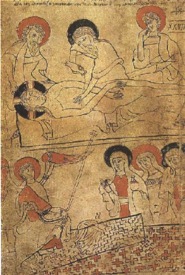

Hungarian Pray Codex
Hungarian Pray Codex
In the Budapest National Library there is an ancient codex, known commonly as the Hungarian Pray Manuscript or Pray Codex, named for György Pray (1723-1801), a Jesuit scholar who made the first detailed study of it. Written between 1192 and 1195, the codex contains five illustrations, one of five is showing Jesus being placed on his burial shroud.
- The shroud is drawn with the same herringbone weave and identical patterns of small burn holes found on the shroud. (These are not the large burns caused by the fire of 1532).
- The artist included a number of other graphic characteristics consistent with the shroud. Jesus is shown naked with his arms modestly folded at the wrists.
- The fingers are unusually long in appearance as they are on the shroud.
- There are no visible thumbs just as there are no thumbs visible in the images of the man of the shroud.
- In the drawing, there is also a clear mark on Jesus' forehead where a prominent 3-shaped bloodstain is found on the forehead of the man of the shroud.
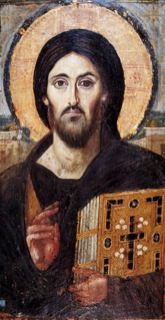
Then do an overlay matching
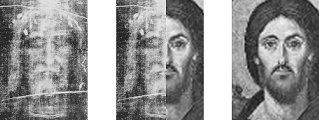
Oddly is works better then using the da Vinci’s image.
In the eighth century Pope Stephen III (reigned 752 to 757 CE) stated that Christ had “spread out his entire body on a linen cloth that was white as snow. On this cloth, marvelous as it is to see . . . the glorious image of the Lord's face, and the length of his entire and most noble body, has been divinely transferred.”
see link of resources
James Barrett
www.jamesabarrett.com
www.silentgospel.com

All Material Reserved- Copyrighted 2007-2008-2009 -2010- 2011
James Andrew Barrett - Silent Gospel Publishing
